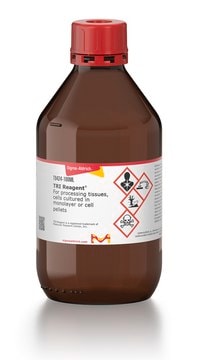推荐产品
等級
for molecular biology
形狀
buffered aqueous glycerol solution
濃度
≥10000 units/mL
10,000 units/mL
運輸包裝
wet ice
儲存溫度
−20°C
正在寻找类似产品? 访问 产品对比指南
特異性
Recognition sequence: 5′-A/AGCTT-3′
Cutting results: 2-10-fold Hind III overdigestion of 1 μg λ DNA substrate results in 100% cutting
Heat inactivation: 65 °C for 15 minutes
Cutting results: 2-10-fold Hind III overdigestion of 1 μg λ DNA substrate results in 100% cutting
Heat inactivation: 65 °C for 15 minutes
應用
HindIII, a restriction endonuclease, is used in molecular biology applications to cleave DNA at the recognition site 5′-A/AGCTT-3′ to generate DNA fragments with cohesive 5′-ends.
其他說明
Supplied with 10x Restriction Enzyme Buffer SB (B8781)
Comment: Hind III under suboptimal reaction conditions will cleave secondary recognition sites (star activity).
外觀
Solution in 10 mM Tris-HCl, pH 7.5, 0.1 mM EDTA, 1 mM dithioerythritol, 250 mM NaCl, 0.01% polydocanol (v/v), 50% glycerol (v/v) at 4 °C
儲存類別代碼
12 - Non Combustible Liquids
水污染物質分類(WGK)
WGK 1
閃點(°C)
Not applicable
Stephen J King et al.
Molecular biology of the cell, 14(12), 5089-5097 (2003-10-21)
Cytoplasmic dynein and dynactin are megadalton-sized multisubunit molecules that function together as a cytoskeletal motor. In the present study, we explore the mechanism of dynein-dynactin binding in vitro and then extend our findings to an in vivo context. Solution binding
M Hsu et al.
Biochemistry, 17(1), 131-138 (1978-01-10)
In the presence of 100 mM Tris buffer (pH 7.5) and 1-10 mM Mg2+ EcoRI endonuclease cleaves DNA at a specific nucleotide sequence and in a characteristic way: -GAATTC-. But if Mg2+ is replaced by Mn2+, the specificity of the
Tomás Brdicka et al.
The Journal of experimental medicine, 196(12), 1617-1626 (2002-12-18)
A key molecule necessary for activation of T lymphocytes through their antigen-specific T cell receptor (TCR) is the transmembrane adaptor protein LAT (linker for activation of T cells). Upon TCR engagement, LAT becomes rapidly tyrosine phosphorylated and then serves as
C Kessler et al.
Gene, 92(1-2), 1-248 (1990-08-16)
The properties and sources of all known class-I, class-II and class-III restriction endonucleases (ENases) and DNA modification methyltransferases (MTases) are listed and newly subclassified according to their sequence specificity. In addition, the enzymes are distinguished in a novel manner according
Cong Zhu et al.
Nucleic acids research, 41(4), 2455-2465 (2013-01-11)
Zinc-finger nucleases (ZFNs) have been used for genome engineering in a wide variety of organisms; however, it remains challenging to design effective ZFNs for many genomic sequences using publicly available zinc-finger modules. This limitation is in part because of potential
我们的科学家团队拥有各种研究领域经验,包括生命科学、材料科学、化学合成、色谱、分析及许多其他领域.
联系技术服务部门





